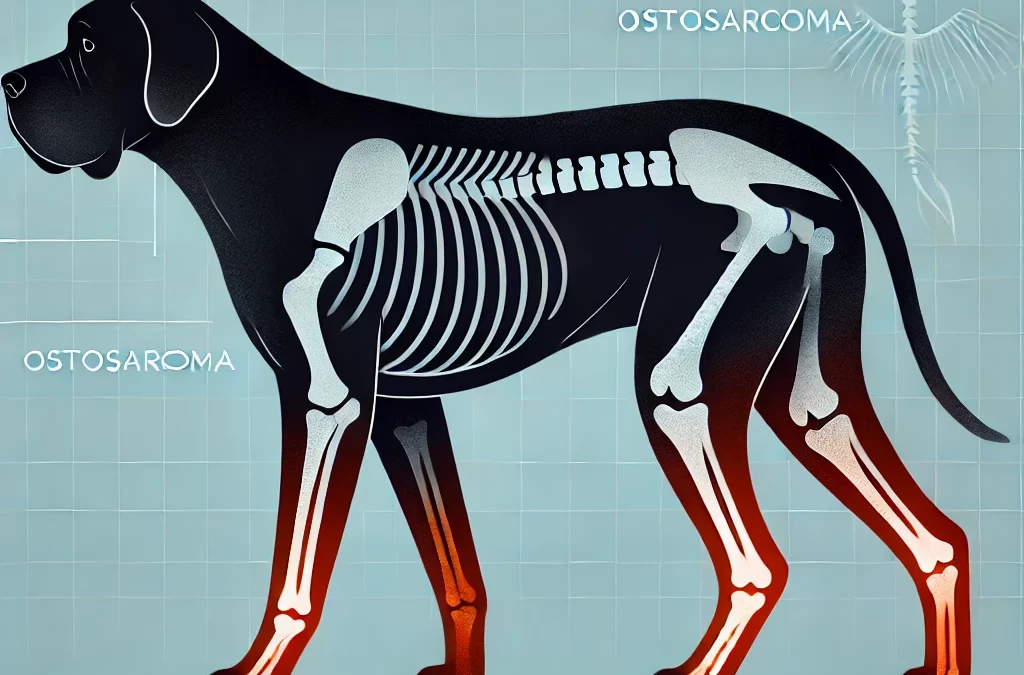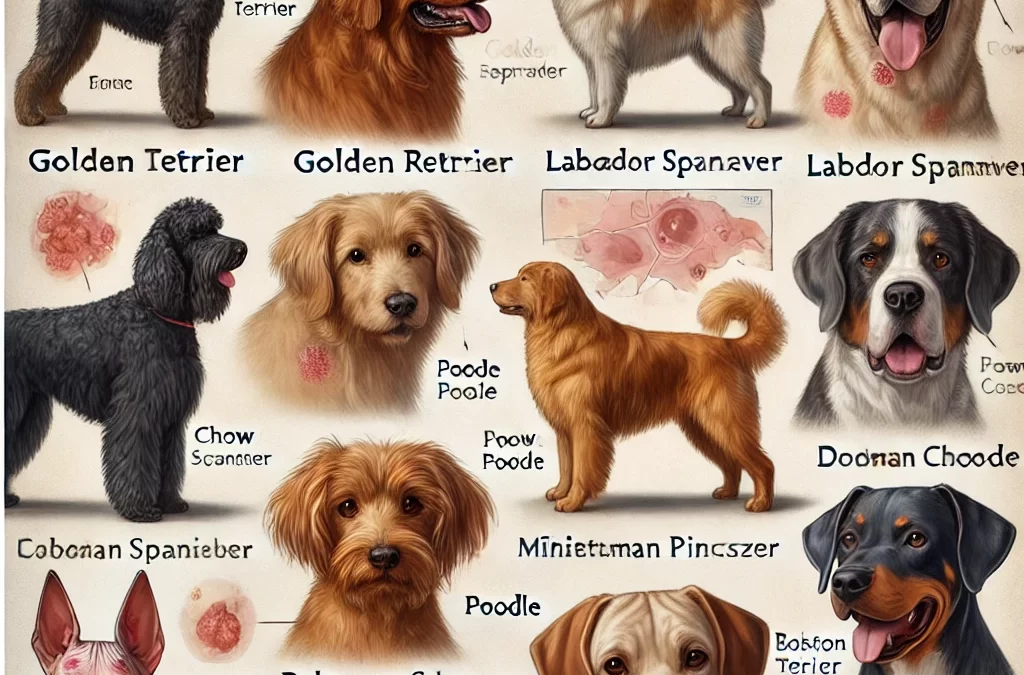
utworzone przez TCMVET | 6 lutego 2025 | Rak i guzy u psów
Rak jest coraz większym zmartwieniem właścicieli zwierząt domowych, zwłaszcza tych, którzy mają wiele psów. Kiedy u psa w domu zostanie zdiagnozowany rak, pojawia się powszechne pytanie: Czy rak u psów jest zaraźliwy? Zrozumienie natury raka i sposobu, w jaki się rozprzestrzenia, może pomóc właścicielom zwierząt domowych podjąć odpowiednie środki ostrożności, zapewniając jednocześnie najlepszą opiekę swoim futrzanym towarzyszom.
Czy rak jest zaraźliwy u psów?
Prosta odpowiedź brzmi: NIE—większość form raka u psów to nie zaraźliwy. W przeciwieństwie do chorób zakaźnych wywołanych przez wirusy lub bakterie, rak to niekontrolowany wzrost nieprawidłowych komórek w ciele jednostki. Nie rozprzestrzenia się z jednego psa na drugiego poprzez bezpośredni kontakt, wspólne miski z jedzeniem lub bliskość.
Jednakże istnieją rzadkie wyjątki, takie jak przenoszone drogą płciową nowotwory (TVT), który może rozprzestrzeniać się poprzez bezpośredni kontakt, szczególnie podczas krycia. TVT jest jednym z nielicznych naturalnie występujących nowotworów przenoszonych u psów i dotyka głównie psy bezdomne lub niekastrowane. Poza tym konwencjonalne nowotwory, takie jak chłoniak, kostniakomięsak i guzy komórek tucznych, nie mogą być przenoszone między psami.
Czy czynniki środowiskowe mogą mieć wpływ na rozwój raka?
Chociaż sam rak nie jest zaraźliwy, psy mieszkające w tym samym domu mogą mieć podobne objawy. typowe zagrożenia środowiskowe które mogą przyczynić się do rozwoju raka. Należą do nich:
- Narażenie na bierne palenie – Psy w domach, w których pali się tytoń, mają większe ryzyko zachorowania na raka płuc i guzy nosa.
- Toksyczne substancje chemiczne – Pestycydy, herbicydy i domowe środki czyszczące mogą zwiększać ryzyko zachorowania na raka u zwierząt domowych.
- Dieta i otyłość – Zła dieta i stany zapalne związane z otyłością mogą z czasem przyczynić się do rozwoju raka.
- Genetics – Jeśli w gospodarstwie domowym jest kilka psów tej samej linii krwi lub tej samej rasy, mogą one mieć genetyczne predyspozycje do niektórych nowotworów.
Co powinni zrobić właściciele wielu psów?
Mimo że rak nie jest chorobą zaraźliwą, właściciele zwierząt powinni podjąć pewne środki ostrożności, aby zapewnić zdrowie i dobre samopoczucie wszystkich swoich psów:
1. Utrzymuj zdrowe środowisko
- Utrzymuj swój dom wolny od szkodliwych toksyn, w tym dymu papierosowego i silnych substancji chemicznych.
- Unikaj stosowania pestycydów i herbicydów w miejscach, w których bawią się Twoje psy.
2. Wspieraj odżywczą dietę
- Podawaj psu zbilansowaną, wysokiej jakości karmę ze świeżych, naturalnych składników.
- Rozważ suplementację wspomagającą zdrowie układu odpornościowego, np. kwasami tłuszczowymi omega-3 i przeciwutleniaczami.
3. Monitoruj objawy u innych psów
- Regularnie sprawdzaj, czy nie występują guzki, obrzęki, utrata masy ciała lub zmiany w zachowaniu.
- Zaplanuj coroczne kontrole weterynaryjne i rutynowe badania przesiewowe w kierunku raka, zwłaszcza w przypadku starszych psów lub ras podatnych na raka.
4. Zapewnij wsparcie emocjonalne
- Jeśli u jednego psa zostanie zdiagnozowany rak, u innych psów w domu może dojść do stresu lub zmian w zachowaniu.
- Utrzymuj stałą rutynę i zapewnij komfort wszystkim zwierzętom domowym.
5. Skonsultuj się z lekarzem weterynarii
- Jeśli masz wątpliwości dotyczące ryzyka wystąpienia raka w swoim domu, skonsultuj się z lekarzem weterynarii, który udzieli Ci spersonalizowanych porad dotyczących profilaktyki i wczesnego wykrywania.
Wnioski
Rak u psów nie jest zaraźliwy, ale wspólne czynniki środowiskowe i predyspozycje genetyczne mogą wpływać na ryzyko zachorowania na raka u wielu psów w gospodarstwie domowym. Utrzymując zdrowy dom, zapewniając odpowiednie odżywianie i zachowując czujność na objawy, właściciele zwierząt domowych mogą pomóc swoim psom żyć dłużej i zdrowiej. Jeśli u jednego z Twoich psów zostanie zdiagnozowany rak, zapewnienie miłości, pocieszenia i odpowiedniej opieki medycznej jest najlepszym sposobem na wsparcie go, zapewniając jednocześnie dobre samopoczucie całego stada.

utworzone przez TCMVET | sty 26, 2025 | Rak i guzy u psów
Mięsak kościopochodny (OSA) jest najczęstszym pierwotnym nowotworem kości u psów i nieproporcjonalnie dotyka duże i olbrzymie rasy. Ze względu na swoją agresywną naturę i szybkie przerzuty, ten nowotwór stanowi poważne wyzwanie dla właścicieli zwierząt domowych. Jednak zrozumienie czynników ryzyka i przyjęcie strategii zapobiegawczych może mieć znaczenie. W tym artykule zbadano, dlaczego duże psy są bardziej podatne na mięsaka kościopochodnego i jakie proaktywne kroki mogą podjąć właściciele, aby zminimalizować ryzyko.
Dlaczego duże i olbrzymie rasy są bardziej podatne na kostniakomięsaka?
- Szybki wzrost i rozwój kości
Duże i olbrzymie psy rosną szybko w pierwszych miesiącach życia, co obciąża ich kości. Ten szybki wzrost może prowadzić do mikrouszkodzeń w strukturach kostnych, co stwarza predyspozycje do mutacji nowotworowych.
- Czynniki genetyczne
Niektóre rasy mają genetyczną predyspozycję do osteosarcoma. Do najczęściej dotkniętych ras należą:- Dog niemiecki
- Święty Bernard
- Wilczarz irlandzki
- Rottweilera
- Chart
- Labrador retriever
- Golden retriever
- Długość kończyny i obciążenie kości
Wyższe psy z długimi kończynami są bardziej podatne na stres kostny. Mięsak kości często występuje w kościach nośnych, takich jak kość promieniowa, łokciowa, ramieniowa i udowa.
- Wpływ hormonów i sterylizacja/kastracja
Badania sugerują, że wczesna sterylizacja lub kastracja, szczególnie przed osiągnięciem dojrzałości kostnej, może zwiększać ryzyko wystąpienia kostniakomięsaka. Uważa się, że jest to związane z usunięciem hormonów płciowych, które odgrywają rolę w regulacji wzrostu kości.
- Przewlekły stan zapalny i uraz kości
Wielokrotne urazy, wcześniejsze złamania lub operacje ortopedyczne mogą zwiększać podatność na nowotwory u psów, szczególnie u ras predysponowanych do występowania kostniakomięsaka.
Jak zmniejszyć ryzyko wystąpienia kostniakomięsaka u dużych psów
- Kontrolowany wzrost w okresie szczenięcym
- Unikaj wysokokalorycznych diet sprzyjających szybkiemu wzrostowi, które stanowią nadmierne obciążenie dla rozwijających się kości.
- Szczeniętom dużych ras podawaj specjalnie opracowaną karmę, która zapewnia stały, kontrolowany wzrost.
- Zrównoważona dieta z przeciwutleniaczami
- Włącz do jadłospisu produkty bogate w kwasy tłuszczowe omega-3, kurkuma i przeciwutleniacze do walki ze stanami zapalnymi i stresem oksydacyjnym.
- Dieta z kontrolowanym poziomem wapnia i fosforu wspomaga zdrowie kości, nie powodując ich przerostu.
- Odpowiedzialna sterylizacja i kastracja
- Warto rozważyć odroczenie zabiegu sterylizacji do momentu, aż pies osiągnie dojrzałość szkieletową (zwykle około 18–24 miesięcy w przypadku dużych ras).
- Omów alternatywne opcje sterylizacji z lekarzem weterynarii, aby zrównoważyć ryzyko zachorowania na raka ze zdrowiem reprodukcyjnym.
- Regularne ćwiczenia bez nadmiernego wysiłku
- Ćwiczenia o niewielkim wpływie na organizm, takie jak pływanie czy spacery, pomagają zachować zdrowie kości i stawów.
- Unikaj nadmiernych skoków i powtarzalnych czynności o dużym wpływie, szczególnie w przypadku młodych psów.
- Wczesne wykrywanie i rutynowe badania kontrolne
- Regularne badania weterynaryjne pozwalają wykryć drobne zmiany w kościach na wczesnym etapie.
- Właściciele powinni monitorować oznaki takie jak: utykanie, obrzęki kończyn, uporczywy ból lub nagłe trudności w poruszaniu się.
- Suplementy wzmacniające kości
- Glukozamina i chondroityna: Wspomaga integralność stawów i kości.
- Witamina D i K2: Pomaga w absorpcji wapnia i gęstości kości.
- Kurkumina i grzyby lecznicze: Wykazuje właściwości przeciwzapalne i potencjalnie przeciwnowotworowe.
- Unikanie toksyn środowiskowych
- Ogranicz narażenie na znane czynniki rakotwórcze, takie jak pestycydy, dym tytoniowy i przetworzoną karmę dla zwierząt ze sztucznymi dodatkami.
Końcowe przemyślenia
Podczas gdy psy dużych i olbrzymich ras są bardziej narażone na kostniakomięsaka, profilaktyka może odegrać znaczącą rolę w zmniejszeniu tego zagrożenia. Dobrze zbilansowana dieta, kontrolowane ćwiczenia, odpowiedzialna hodowla i regularne monitorowanie stanu zdrowia mogą pomóc właścicielom zwierząt domowych skutecznie zarządzać ryzykiem. Bycie proaktywnym nie tylko wydłuża życie psa, ale także poprawia jego ogólną jakość życia. Jeśli zauważysz jakiekolwiek oznaki kulawizny lub obrzęku, skonsultuj się z lekarzem weterynarii, ponieważ wczesna diagnoza ma kluczowe znaczenie dla poprawy wyników.

utworzone przez TCMVET | sty 26, 2025 | Rak i guzy u psów
Czerniak jest jednym z najbardziej niepokojących nowotworów u psów, często pojawiającym się w jamie ustnej, skórze, łożyskach paznokci, a nawet oczach. Podczas gdy wszystkie psy mogą zachorować na czerniaka, niektóre rasy są genetycznie predysponowane ze względu na pigmentację, cechy skóry i inne czynniki biologiczne. W tym artykule zbadano, które rasy psów są bardziej podatne na czerniaka, rolę czynników środowiskowych i w jaki sposób właściciele zwierząt domowych mogą podjąć środki zapobiegawcze.
Dlaczego niektóre rasy są bardziej podatne na czerniaka?
Melanoma powstaje z melanocytów, komórek produkujących pigment w ciele psa. Następujące czynniki przyczyniają się do zwiększonego ryzyka u niektórych ras:
- Predyspozycje genetyczne – Niektóre rasy dziedziczą większe prawdopodobieństwo nieprawidłowego wzrostu melanocytów.
- Pigmentacja i kolor sierści – Psy o ciemnej pigmentacji, szczególnie rasy o czarnym umaszczeniu, są często bardziej podatne na czerniaka jamy ustnej. Z kolei psy o jasnej pigmentacji są bardziej podatne na czerniaka skóry w miejscach narażonych na działanie słońca.
- Wyzwalacze środowiskowe – Długotrwałe przebywanie na słońcu, funkcjonowanie układu odpornościowego, a nawet dieta mogą mieć wpływ na rozwój czerniaka u psów.
Rasy o wyższym ryzyku wystąpienia czerniaka
Badania i studia przypadków weterynaryjnych wskazują, że poniższe rasy mają większe ryzyko zachorowania na czerniaka:
- Szkocki terier – Często wiąże się z czerniakiem skóry, zwłaszcza w miejscach narażonych na działanie promieni słonecznych.
- Golden retriever – Podatne na różne rodzaje nowotworów, w tym czerniaka, szczególnie w jamie ustnej.
- Labrador retriever – Zgłaszano zwiększoną liczbę przypadków czerniaka jamy ustnej.
- Cocker Spaniel – Częstsze występowanie czerniaka, szczególnie w oczach (czerniak oka).
- Chow Chow – Ich ciemna pigmentacja zwiększa podatność na czerniaka jamy ustnej.
- Pudel – U pudli miniaturowych i dużych zdiagnozowano czerniaka łożyska paznokcia.
- Jamnik – Większe prawdopodobieństwo wystąpienia czerniaka skóry ze względu na czynniki genetyczne.
- Doberman Pinczer – Większa częstość występowania czerniaka jamy ustnej i łożyska paznokcia.
- Sznaucer miniaturowy – Podatny na czerniaka skóry i jamy ustnej.
- Boston Terrier – Zwiększone ryzyko wystąpienia czerniaka skóry, zwłaszcza u osób o jasnej karnacji.
Czynniki środowiskowe i związane ze stylem życia, które zwiększają ryzyko
Nawet jeśli pies nie należy do rasy wysokiego ryzyka, czynniki zewnętrzne mogą wpływać na rozwój czerniaka:
- Ekspozycja na słońce – Psy o jasnej skórze lub cienkim futrze są narażone na czerniaka skóry wywołanego promieniowaniem UV.
- Higiena jamy ustnej – Niewłaściwa pielęgnacja jamy ustnej może przyczyniać się do stanów zapalnych, co potencjalnie zwiększa ryzyko wystąpienia czerniaka jamy ustnej.
- Wiek – Starsze psy są bardziej podatne na mutacje komórkowe prowadzące do czerniaka.
- Toksyny i dieta – Narażenie na działanie substancji chemicznych i brak przeciwutleniaczy w diecie psa może mieć wpływ na podatność na raka.
Środki zapobiegawcze dla właścicieli psów
- Rutynowe kontrole weterynaryjne – Wczesne wykrycie jest kluczowe, zwłaszcza w przypadku ras wysokiego ryzyka.
- Badania jamy ustnej i skóry – Regularnie sprawdzaj wnętrze pyska, łap i skóry psa pod kątem nietypowych narośli.
- Ochrona przeciwsłoneczna – Psy o jasnej karnacji powinny unikać nadmiernej ekspozycji na słońce, a w tym celu należy stosować bezpieczne dla zwierząt kremy z filtrem przeciwsłonecznym.
- Zrównoważona dieta – Antyoksydanty i kwasy tłuszczowe omega-3 wspomagają funkcjonowanie układu odpornościowego i zmniejszają stany zapalne.
- Dbaj o zdrowie jamy ustnej – Szczotkowanie zębów psa i podawanie mu gryzaków dentystycznych może zmniejszyć ryzyko wystąpienia czerniaka jamy ustnej.
Końcowe przemyślenia
Chociaż czerniak jest agresywnym nowotworem, świadomość ryzyka związanego z rasą i proaktywna opieka mogą pomóc we wczesnym wykrywaniu i zapobieganiu. Regularne kontrole, zdrowa dieta i czujny monitoring mogą mieć znaczący wpływ na zdrowie psa. Jeśli zauważysz jakiekolwiek nietypowe grudki, zwłaszcza w pysku psa, jak najszybciej zasięgnij porady lekarza weterynarii.

utworzone przez TCMVET | sty 22, 2025 | Rak i guzy u psów
Właściciele zwierząt domowych poszukują alternatyw dla konwencjonalnych metod leczenia raka, takich jak operacja, chemioterapia i radioterapia, Tradycyjna medycyna chińska (TCM) wyłoniło się jako obiecujące podejście uzupełniające dla psów z guzami. TCM postrzega raka jako brak równowagi w witalnej energii organizmu (Qi) i ma na celu przywrócenie harmonii poprzez ziołolecznictwo, akupunktura i terapia dietetyczna. Ale jak skuteczne to jest? I jak możemy zintegrować te metody leczenia z holistycznym planem opieki onkologicznej dla psów?
W tym artykule podważono konwencjonalne poglądy na temat leczenia raka u psów, zagłębiając się w temat starożytna mądrość TCMłącząc ją z nowoczesną wiedzą weterynaryjną, aby zaoferować świeże spojrzenie na naturalne leczenie.
1. Zrozumienie raka u psów z perspektywy TCM
W medycynie zachodniej rak jest postrzegany jako niekontrolowany wzrost komórek często wywoływane przez czynniki genetyczne, środowiskowe lub dietetyczne. TCM jednak interpretuje guzy inaczej:
- Stagnacja Qi i Krwi: Guzy powstają, gdy energia i krew zostają zablokowane, co uniemożliwia prawidłowe krążenie.
- Gromadzenie się wilgoci i flegmy: Nadmiar wilgoci w organizmie może kondensować się w postaci skupisk.
- Niedobór nerek i śledziony: Osłabiona funkcja narządów może prowadzić do gromadzenia się toksyn, co zmniejsza zdolność organizmu do usuwania nieprawidłowych komórek.
Leczenie TCM koncentruje się na usuwanie blokad, wzmacnianie funkcji organów i wzmacnianie odporności zamiast po prostu niszczyć komórki rakowe.
2. Medycyna ziołowa: naturalne podejście do redukcji guza
Chińskie formuły ziołowe na raka mają na celu zmniejszać guzy, wzmacniać funkcje odpornościowe i wspierać zdrowie narządówDo powszechnie stosowanych ziół zalicza się:
- Baituxiao (hiszpański): Znany ze swojej zdolności hamowania wzrostu guzów, usuwania gorąca i detoksykacji organizmu.
- Huang Qi (黄芪, Astragalus): Wzmacnia odporność i poprawia przepływ energii, często stosowany w połączeniu z konwencjonalnymi metodami leczenia.
- Ban Zhi Lian (半枝莲, Scutellaria Barbata): Posiada właściwości przeciwnowotworowe i wspomaga zdrowie wątroby.
- Ling Zhi (灵芝, Grzyb Reishi): Silny adaptogen, który wzmacnia odpowiedź immunologiczną i zmniejsza stan zapalny.
- Dang Gui (当归, Angelica Sinensis): Poprawia krążenie krwi i zapobiega zastojom Qi, powszechnie stosowany w leczeniu guzów skóry lub mięśni.
Zioła te są często przepisywane w formułach dostosowanych do potrzeb psa specyficzna konstytucja i typ guza, co sprawia, że spersonalizowane podejście jest niezbędne.
3. Akupunktura: Leczenie bólu i aktywacja gojenia
Akupunktura jest szeroko stosowana w pacjenci z rakiem u ludzi aby złagodzić ból i poprawić samopoczucie, a te same zasady dotyczą psów. Ta praktyka działa poprzez stymulację konkretne punkty meridianowe, Który:
- Zmniejsza stan zapalny i ból
- Poprawia krążenie, pomagając zmniejszyć guzy
- Wspomaga układ odpornościowy, spowalniając postęp nowotworu
- Poprawia trawienie i poziom energii u osłabionych psów
Sesje akupunktury są nieinwazyjny i dobrze tolerowane przez większość psów. Wielu właścicieli zwierząt domowych zauważa poprawę w ich zdrowiu mobilność, wygoda i apetyt po leczeniu.
4. Terapia dietetyczna: leczenie poprzez jedzenie
W medycynie chińskiej żywność jest lekarstwem, a dostosowanie diety odgrywa kluczową rolę. wspierając psy chore na rakaCelem jest zmniejsza stan zapalny, odżywia Qi i zapobiega wzrostowi guza poprzez zbilansowane odżywianie.
Polecane produkty spożywcze:
- Chude białka:Mięso kaczki, królika i ryby jest preferowane zamiast czerwonego mięsa, które może powodować stany zapalne.
- Warzywa przeciwzapalne:Marchewka, brokuły i grzyby, takie jak shiitake i maitake.
- Zdrowe zboża:Proso, komosa ryżowa i jęczmień, które wzmacniają układ trawienny.
- Bulion kostny:Wspomaga trawienie i dostarcza niezbędnych minerałów.
Produkty spożywcze, których należy unikać:
- Przetworzona żywność ze sztucznymi dodatkami
- Nadmierna ilość tłustych lub oleistych potraw, które przyczyniają się do powstawania wilgoci
- Słodycze, ponieważ uważa się, że cukier karmić wzrost guza
Starannie dobrana dieta w połączeniu z ziołami i akupunkturą może pomagają utrzymać odpowiedni poziom energii i poprawić ogólną odporność psa przeciwko rakowi.
5. Integracja TCM z konwencjonalnymi metodami leczenia
Choć TCM oferuje skuteczne narzędzia do leczenia nowotworów u psów, najlepiej sprawdza się, gdy: w połączeniu z zachodnią opieką weterynaryjną. Wielu weterynarzy obecnie przyjmuje podejście integracyjne, stosując TCM w połączeniu z zabiegiem chirurgicznym, radioterapią lub chemioterapią w celu:
- Zmniejsz skutki uboczne konwencjonalnych metod leczenia
- Wzmocnij organizm psa przeciwko nawrotom raka
- Poprawa ogólnego komfortu i trwałości
6. Kiedy rozważyć TCM w przypadku psa chorego na raka
TCM jest szczególnie korzystna, gdy:
- Operacja nie wchodzi w grę ze względu na umiejscowienie guza i wiek psa.
- U psa występują poważne skutki uboczne chemioterapii i radioterapii.
- Celem jest opieka paliatywna aby przedłużyć jakość życia, a nie leczyć raka.
Ponieważ każdy pies reaguje inaczej, praca z Lekarz weterynarii przeszkolony w zakresie TCM zapewnia bezpieczny i skuteczny plan leczenia.
Holistyczna przyszłość opieki nad psami chorymi na raka
Tradycyjna medycyna chińska zapewnia delikatny, ale silny podejście do leczenia nowotworów u psów poprzez zajęcie się przyczyna źródłowa a nie tylko objawy. Poprzez włączenie ziołolecznictwo, akupunktura i terapia dietetycznawłaściciele zwierząt domowych mogą poprawić samopoczucie swojego psa i oferują pełną współczucia, naturalną drogę do uzdrowienia.
Leczenie raka nie powinno koncentrować się wyłącznie na przedłużaniu życia, ale także na poprawa jakości każdego dnia. Przy zachowaniu właściwej równowagi TCM i medycyna zachodnia, psy mogą cieszyć się wygodniejsza i bardziej satysfakcjonująca podróżnawet w obliczu diagnozy raka.

utworzone przez TCMVET | sty 22, 2025 | Rak i guzy u psów
Rak kości, szczególnie kostniakomięsak, jest jednym z najbardziej agresywnych nowotworów u psów. Powoduje intensywny ból, często wynikający z wzrostu guza, stanu zapalnego i uszkodzenia kości, i może prowadzić do powikłań, takich jak złamania lub przerzuty do płuc. Dla właścicieli zwierząt domowych wyzwaniem jest radzenie sobie z tym bólem, jednocześnie zapewniając psu jak najbardziej satysfakcjonujące i komfortowe życie.
W tym artykule przyjrzymy się innowacyjnym metodom łagodzenia bólu i poprawy jakości życia psów chorych na raka kości, łączącym tradycyjne metody leczenia, naturalne środki zaradcze i praktyczne zmiany w stylu życia.
Zrozumienie bólu u psów z rakiem kości
Ból związany z rakiem kości ma wiele przyczyn:
- Wzrost guza: Komórki nowotworowe atakują zdrową tkankę kostną, powodując jej niestabilność strukturalną.
- Zapalenie: Reakcją organizmu na raka często jest obrzęk i dyskomfort.
- Mikropęknięcia: W miarę osłabiania się kości nawet normalna aktywność może powodować bolesne złamania.
Rozpoznanie oznak bólu jest kluczowe. Psy często wykazują:
- Utykanie lub unikanie obciążania chorej kończyny
- Niepokój, szczególnie w nocy
- Nadmierne lizanie lub żucie dotkniętego obszaru
- Utrata apetytu i ogólne osłabienie
- Wrażliwość lub drażliwość w przypadku dotyku
Skuteczne opcje leczenia bólu
Zarządzanie bólem jest podstawą opieki nad psami z rakiem kości. Opcje obejmują:
- Leki łagodzące ból
- Niesteroidowe leki przeciwzapalne (NLPZ): Łagodzą stany zapalne i przynoszą umiarkowaną ulgę w bólu.
- Opioidy: W przypadku silnego bólu często przepisuje się leki takie jak tramadol lub morfina.
- Bisfosfoniany: Leki te pomagają zmniejszyć rozpad kości i mogą łagodzić ból.
- Radioterapia paliatywna
Radioterapia może zmniejszyć guzy i zmniejszyć stan zapalny, zapewniając znaczną ulgę w bólu. Jest szczególnie skuteczna, gdy operacja nie jest opcją.
- Amputacja lub operacja oszczędzająca kończynę
W niektórych przypadkach usunięcie chorej kończyny lub przeprowadzenie zabiegu chirurgicznego w celu ustabilizowania kości może znacznie zmniejszyć ból i poprawić ruchomość.
- Terapie integracyjne i naturalne
- Akupunktura: Udowodniono, że pomaga w leczeniu przewlekłego bólu i poprawia ogólny komfort.
- Olej CBD: Kannabidiol może zmniejszyć ból i stan zapalny, jednocześnie wspomagając relaks. Zawsze skonsultuj się z lekarzem weterynarii w celu ustalenia odpowiedniej dawki.
- Suplementy kurkumy lub kurkuminy: Te naturalne środki przeciwzapalne mogą uzupełniać konwencjonalne metody leczenia.
Poprawa jakości życia
Leczenie bólu to tylko część równania. Aby poprawić codzienne życie psa, rozważ:
- Dostosowanie przestrzeni życiowej
Zapewnij im miękką pościel i łatwy dostęp do jedzenia, wody i terenów zewnętrznych. Rozważ rampy lub antypoślizgowe dywaniki, aby zapewnić bezpieczniejsze poruszanie się.
- Ćwiczenia o niskim wpływie
Delikatne spacery lub pływanie (jeśli to możliwe) mogą pomóc utrzymać siłę mięśni i zapobiec sztywności. Uważnie obserwuj swojego psa, aby uniknąć przemęczenia.
- Wsparcie żywieniowe
- Dieta bogata w białko może pomóc w utrzymaniu masy mięśniowej.
- Produkty o działaniu przeciwzapalnym, takie jak olej rybi lub kwasy tłuszczowe omega-3, mogą wspomagać zdrowie stawów i kości.
- Unikaj wysoko przetworzonych przysmaków i karmy, ponieważ mogą one zaostrzać stan zapalny.
- Stymulacja mentalna
Zajmuj psa puzzlami, spokojną zabawą lub interaktywnymi zabawkami, aby wspierać jego dobre samopoczucie emocjonalne.
Kiedy szukać pomocy
Ważne jest, aby regularnie oceniać stan psa u weterynarza. Zwróć uwagę na oznaki, że ból może się nasilać, takie jak uporczywa odmowa jedzenia, zwiększona letarg lub wokalizacje dyskomfortu. W zaawansowanych stadiach konieczne może okazać się omówienie humanitarnych opcji, takich jak opieka paliatywna lub eutanazja.
Holistyczne podejście do opieki
Łącząc nowoczesną medycynę z holistycznymi i stylowymi interwencjami, możesz znacznie złagodzić ból u swojego psa, jednocześnie poprawiając jego ogólną jakość życia. Podróż każdego psa jest wyjątkowa, a przy odpowiedniej opiece nawet psy zmagające się z rakiem kości mogą doświadczać znaczących i radosnych chwil ze swoimi rodzinami.
Pamiętaj, że Twoja miłość i uwaga mają ogromne znaczenie.

utworzone przez TCMVET | sty 21, 2025 | Rak i guzy u psów
Kiedy ukochany pies otrzymuje diagnozę guza, wielu właścicieli zwierząt domowych staje przed trudnym pytaniem: Jak długo mój pies może żyć bez operacji? Odpowiedź nie jest prosta, ponieważ czas przeżycia zależy od różnych czynników, w tym rodzaju guza, jego rozmiaru, lokalizacji i ogólnego stanu zdrowia. W tym artykule badamy różne rodzaje guzów, alternatywne podejścia do leczenia i sposoby poprawy jakości życia psa bez interwencji chirurgicznej.
1. Zrozumienie typów nowotworów i rokowania
Nie wszystkie guzy zagrażają życiu. Niektóre rosną powoli i powodują niewielkie szkody, podczas gdy inne mogą szybko atakować otaczające tkanki. Oto główne kategorie:
- Łagodne nowotwory: Są one na ogół wolno rosnące i nieinwazyjne. Przykłady obejmują lipomy (guzy tłuszczowe) i łagodne guzy sutka. Psy z łagodnymi guzami często mogą żyć normalnie bez operacji.
- Nowotwory złośliwe: Są agresywne i mogą rozprzestrzeniać się na inne narządy (przerzuty). Przykłady obejmują kostniakomięsaka (rak kości), naczyniakomięsaka (rak naczyń krwionośnych) i guzy komórek tucznych. Bez leczenia oczekiwana długość życia może wynosić od kilku tygodni do kilku miesięcy, w zależności od stadium nowotworu.
- Guzy zlokalizowane: Guzy, które pozostają ograniczone do jednego obszaru, np. niektóre nowotwory skóry, nie mają znaczącego wpływu na długość życia, ale z czasem mogą powodować dyskomfort lub powikłania.
2. Czynniki wpływające na czas przeżycia
Kilka czynników decyduje o tym, jak długo pies może przeżyć z guzem bez konieczności poddania się operacji:
- Szybkość wzrostu guza: Szybko rozwijające się nowotwory, takie jak mięsaki naczyń krwionośnych, mogą zagrażać życiu w ciągu kilku miesięcy, natomiast w przypadku nowotworów rozwijających się powoli poważne problemy mogą pojawić się dopiero po latach.
- Lokalizacja guza: Nowotwory w ważnych narządach, takich jak wątroba, płuca czy mózg, mogą wywołać poważne objawy znacznie szybciej niż nowotwory skóry czy tkanek miękkich.
- Przerzut: Jeśli rak rozprzestrzenił się na inne części ciała, czas przeżycia jest zazwyczaj krótszy.
- Ogólny stan zdrowia: Psy z silnym układem odpornościowym i ogólnie dobrym zdrowiem mogą lepiej znosić nowotwory niż te z chorobami współistniejącymi.
3. Terapie alternatywne i wspomagające
Dla osób, które nie chcą poddawać się zabiegowi chirurgicznemu, dostępne są alternatywne metody leczenia, które mogą pomóc w łagodzeniu objawów i spowolnieniu postępu nowotworu:
- Środki holistyczne i ziołowe: Niektóre zioła, takie jak kurkuma, traganek i grzyby lecznicze (reishi, krwawnik pospolity) mogą wspomagać funkcjonowanie układu odpornościowego i łagodzić stany zapalne.
- Korekty dietetyczne: Dieta o niskiej zawartości węglowodanów i wysokiej zawartości tłuszczu może pomóc spowolnić wzrost komórek rakowych, gdyż rak rozwija się na bazie glukozy.
- Olejek CBD i naturalne łagodzenie bólu: Wielu właścicieli zwierząt domowych twierdzi, że olejek CBD pomaga zmniejszać stany zapalne, łagodzić ból i poprawiać ogólne samopoczucie.
- Akupunktura i fizjoterapia: Zabiegi te mogą pomóc zachować sprawność ruchową, zmniejszyć dyskomfort i poprawić jakość życia psa.
4. Monitorowanie jakości życia
Jeśli operacja nie wchodzi w grę, skupienie się na komforcie i jakości życia jest niezbędne. Objawy wskazujące na pogarszający się stan to:
- Loss of Appetite: Pies, który odmawia jedzenia lub szybko traci na wadze, może potrzebować dodatkowego leczenia wspomagającego.
- Difficulty Breathing: Guzy atakujące płuca lub uciskające drogi oddechowe mogą utrudniać oddychanie.
- Persistent Pain or Discomfort: Jeśli leki przeciwbólowe nie przynoszą już ulgi, może być to czas na omówienie opieki paliatywnej lub eutanazji z lekarzem weterynarii.
- Letarg i izolacja: Gdy pies nie odczuwa już przyjemności z aktywności lub wycofuje się z kontaktów, może to być sygnałem pogarszającego się stanu zdrowia.
5. Kiedy podjąć trudną decyzję
Podczas gdy niektóre psy mogą żyć miesiącami, a nawet latami z guzem, inne mogą doświadczyć szybkiego pogorszenia. Konsultacja z zaufanym weterynarzem jest kluczowa w ocenie, kiedy interwencja lub humanitarna eutanazja są najłaskawszym wyborem.
Wnioski
Długość życia psa z guzem zależy od wielu czynników, ale przy odpowiedniej opiece wiele z nich może nadal żyć wygodnie bez operacji. Zapewniając leczenie bólu, wsparcie dietetyczne i holistyczne terapie, właściciele zwierząt domowych mogą zapewnić swojemu psu jak najwięcej jakościowego czasu. Kluczem jest ścisłe monitorowanie zmian i priorytetowe traktowanie komfortu nad agresywnymi interwencjami, gdy jest to konieczne.






